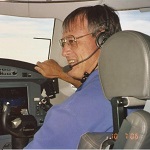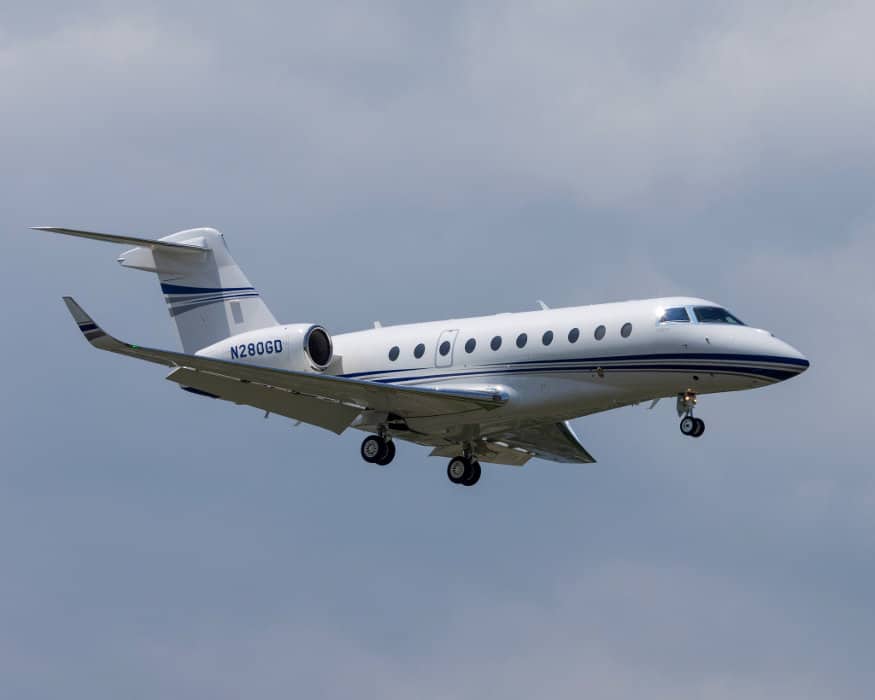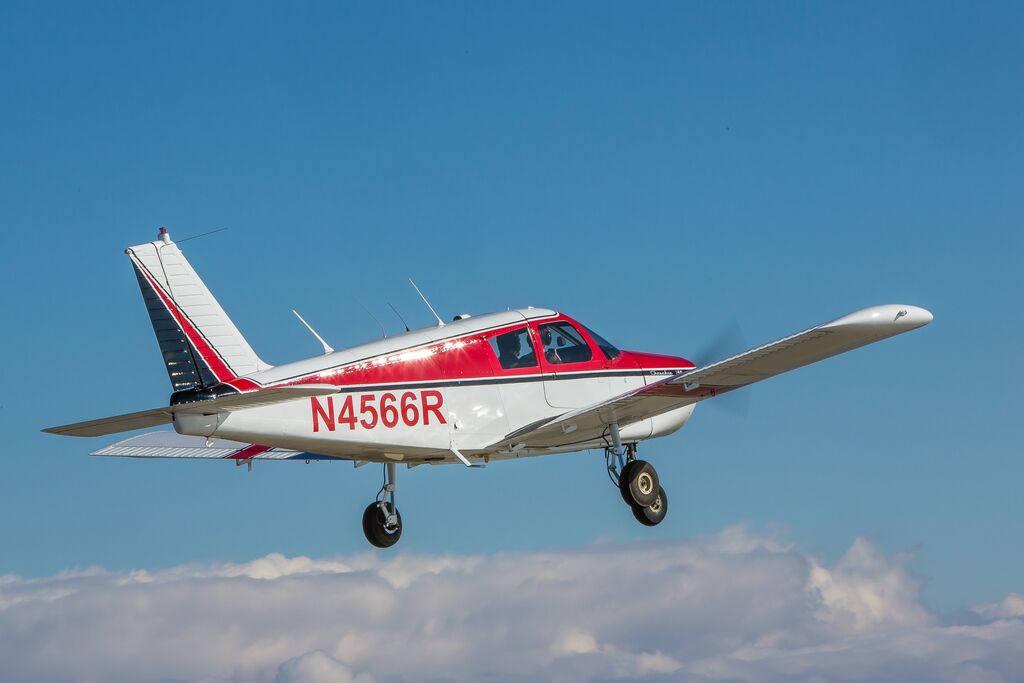A private pilot license used to be attainable in forty hours, but now a pilot is lucky to complete the required training within sixty hours or more!

In an effort to determine why there are 210,000 fewer licensed pilots now than there were in 1980, it’s important to contrast then and now. There is no better way than talking to pilots who have the determination to stay in the industry for an entire lifetime. Howard Bucy has been a flight instructor for thirty-three years. He’s seen the changes, both good and bad, and reminds us all about the common denominator that keeps pilots coming back: the pure joy of flight. Here is what Howard has to say:

After my birthday this past May, I started mulling numbers in my head, as I sometimes will do. It occurred to me that I have been a flight instructor now for thirty-three years….exactly half of my life! And after all this time, I still love it! Thinking back about all the pilots I have trained, I began to reflect on what has remained the same, and what has changed.
The laws of aerodynamics will never change. Thrust is still opposite drag, and lift will always oppose weight or gravity. The age old arguments about whether Bernoulli or Newton contributes more to the creation of lift if a high wing is better than a low wing aircraft, and if pitch controls airspeed or does power? These questions I’m sure will be around until the sun burns out! Something that has not changed over time is the tremendous enthusiasm of pilots as they start on their journey towards a pilot license, learning about aviation and how to fly an airplane. Nothing can compare to the exhilaration coupled with some trepidation when they take off and break that connection to Earth and enter into a three-dimensional environment, with the realization they are in total control of their destiny! While there are many constants in aviation, there have been, and continue to be many changes.
One of the impacts on aviation is the ATP/1500 hour minimum requirement to sit right seat in a commuter aircraft. This increased hourly requirement is an indirect cause for the decline in pilot participation, but the real problem is twofold. It branches into two separate issues: the cost of aircraft rental and career status of flight instructors. Insurance is hurting aviation by causing rental rates to be prohibitively expensive—and that’s if you can even find a rental aircraft! At my home in Denton, TX, there is nobody, anywhere on the field, who you can rent an airplane from unless you enroll in one of their training courses. The situation is then compounded by flight instructors who are using flight instruction just as a stepping stone to career advancement. The odds of keeping the same instructor all the way through training to completion is slim to none. The moment they log enough hours to qualify for another job, they will move on. To give you an example of this, I had a young lady here who came to me in frustration, thinking about giving up on her dream of becoming a pilot because of inconsistent flight instruction. She had over fifty hours, had not gotten to do her solo cross-country flight yet, and was about to be passed off to her third instructor! So, I took her under my wing and finished her up in fifteen hours. We need to promote flight instruction as a viable career option.
 Another change which bogs down the aviation system are the increase in regulations. When I first started flight training in 1968 (am I really that old?!), the FAR-AIM contained only 200 pages. Now it has swollen to the size of phone book!
Another change which bogs down the aviation system are the increase in regulations. When I first started flight training in 1968 (am I really that old?!), the FAR-AIM contained only 200 pages. Now it has swollen to the size of phone book!
Back then, a private pilot license could be attained in forty hours. I finished my training at a 142 school and got my pilot license in thirty-eight hours. Now, a pilot is lucky to complete the required training within about sixty hours! But on the other side of the coin, a major change was in the area of navigation technology. Holy cow, the improvements that have been made, mostly within the past ten years! When I learned to fly, VOR and ILS were the magic nav sources replacing the NDB and Radio Ranges of the day. Then came LORAN and not long after that, the first Area Navigation or RNAV units appeared on the market. With these King Radio units, a pilot could build waypoints based on a radial and DME from a selected VORTAC to “virtually” move the station onto a flight planned course. This allowed accurate off airway navigation with more options for “direct to” operations. Now we have glass cockpits, even in training aircraft, and GPS is the standard for navigation solutions now and into the foreseeable future.
With all of the advancements and changes within the industry, the one constant that I continue to see is the absolute passion that is present in everyone who chooses to engage in aviation! And if there would be one key piece of advice I would offer to my fellow flight instructors, especially the new ones, it would be: don’t get too wrapped up with teaching the technology. This is not what makes an airplane fly. Good old fashioned, stick and rudder airmanship must be taught first and foremost. Then after mastering the aircraft, begin integrating the technology. It’s a balance of basics and technology, but aviation has had a tendency to lean too much on technology, which can become a problem.
In my current position as a flight and sim instructor for the leading training provider in the world, I get to see firsthand the increased reliance on automation with a corresponding degradation of physical flying skills…in pilots with thousands of hours! We strive to provide training that will restore those piloting abilities. As a sim and flight instructor for FlightSafety International teaching pilots how to fly the Gulfstream G280 corporate jet, we have to get the pilots comfortable with all the technology in the cockpit including auto-throttles, auto brakes, flight guidance computer with auto pilot and three flight management systems.

Then when they come back for recurrent training a year later and we start “failing” systems, they have a hard time just physically controlling the aircraft. There have been several high-profile airline accidents attributed directly to problems with cockpit automation coupled with degraded pilot skills. The Asiana crash landing at San Francisco and the Air France Airbus pilots losing control at altitude and plunging into the sea are the most recent examples. Pilots are being trained more as systems managers rather than pilots. But the issues are becoming more apparent so the FAA is now beginning to mandate more emphasis on physical piloting skills now!
In closing, when pursuing a pilot license, I would like to remind everyone of three things: flying should be challenging, it should be rewarding, but most of all it should be fun!















This really hits home.
For as long as I can remember, I’ve wanted to be a pilot…career pilot, mainly. Since I don’t come from a well off family, nor do I make a great income, this dream has gone so far out of reach that it keeps me up some times. I enrolled in college to try and land a job to where I could afford to atleast go get a private license and rent a plane every so often, but debt has sealed the deal. I fear I may never get to fly anymore.
I recently landed a job at the local airport, where I am getting trained to be an AMT, which is wonderful. Being around aircraft makes me happy, but deep down, there is still something missing. Not to mention, my boss, who has been a pilot for a very long time, is extremely discouraging when it comes to the subject of me looking for lessons. He simply states that trying to be a pilot is no longer worth it and I am still far out from ever being able to afford it. Not only is this heart breaking, but it has brought me to tears. I have and always will be willing to trade everything for the chance to be a pilot. It has been my dream since day 1. The older I get, the more I feel that it will always just be a dream. That haunting feeling makes me not even want to live, as I know(and have always known) my purpose in lifelife is to fly.
My entire life, I’ve had my face stuffed in books, learning about aircraft, listening to stories of pilots, and even had plenty of conversations with current pilots…and I feel as though it was all for nothing.
I appreciate your thoughts in this article. Really, it pulls on my heart strings.
As a lover of aviation, I can only wish to have experienced the things you have behind a yolk.
Trey. Keep studying, keep working (maybe 2 jobs), maybe find a new boss with a more positive attitude, and don’t let the dream die. There is a way.
If this is how you feel, you are a pilot in the making…you just don’t know it yet. There is a story about a bunch of frogs trying to climb on top of a tall building. Other frogs were shouting at them “you can’t do it”. One by one they all dropped…all but one. So, they all looked up trying to see which frog made it…and it was the deaf one. If you’re going to listen to voices, better start with your inner one and believe me the whole universe will conspire so that YOU EVENTUALLY BECOME A PILOT AND THERE IS NO OTHER WAY TO IT!
Trey, that is so sad to hear you say all those words, although some may be true – it does not mean they are your destiny,
Im sure you’ve already been doing this for years, but please continue to block out any negativity that is thrown towards you. Other peoples words are irrelevant. Some people find success in later life, after they’ve spent most of their life working for it, and most of the time after being shoved into the ground. Don’t compare yourself to others and where they are in their life success-wise, focus on YOUR success and how you’re going to get there. Im still only young – but ive personally received a ridiculous amount of negativity from family, friends, colleagues.. since i was 14 years old (since my dream began) im now 21 and im learning more and more about mental strength and to just.. keep.. going. It doesnt help being a female either for me, its surprising how much sexism still exists in this world.
At the end of the day – no one will stop you except for you. And no one will succeed for you, only YOU.
Be strong. Be powerful. Be positive. and NEVER stop at anything. Even if you’re 50 by the time you achieve your PPL – WHO CARES. You will have achieved a life goal you longed for and it will be one of the happiest moments of your life.
Just live for your dream. Always.
Very well explained sir,
I totally agree
It has taken me nearly 30 years to log 30 hours pilot training in UK,
Please don’t give up on your dreams,
I did because I got married instead 🤣😭
A great article with a lot of insight! When I was a kid I wanted to learn how to play the guitar, in order to play my favourite tunes…well…bits of the them. The guitar instructor had a different opinion on the matter and was way too “technical”. I had to learn about music…good thing he didn’t make me memorize some great composer’s biography. I got bored and surely enough I quit, until I was much older and started playing riffs from tutorials on youtube. Point is, there is a lot to learn about aviation. Start by making it fun. I know you can’t perform a loop (opinion on the matter is divided) in a C-172, however, lazy eights and tight turns are a great deal of fun. Get them to aviate first, get real hands-on experience and everything else will come. Oh yes…and whatever happened to old aviation movies that have inspired generations of aviators?
#Trey. Make a plan. Write it out. Review it daily. Figure out a realistic goal you want to reach, figure out what concrete steps it will take to get there and what behaviors you need to work on to be successful at those steps, and then go make it happen. Adjust as you go. You will find that you usually only have to adjust to account for the fact that you achieve more than you set out to. If you are young, as I am, the demographics are in your favor. It is getting easier and easier to set yourself apart from others and achieve. Show up, keep showing up, play the game (no matter the game) with excellence, and watch the rest of the world fall behind.
Speaking of demographics, I read recently that the pilot numbers are dropping (due to pilots aging out and loosing medicals) but that we have more student pilot starts than we have since the 80’s. We have a huge generation of “millennials” coming into their own and finally having money to raise a family and fly. Describes me exactly.
Best of luck.
Trey, don’t listen to negative people and please don’t ever give up on your dream! While I started flying when I was 19, life kept getting in the way and I didn’t get my private license until I was 25! Then adding all the other ratings was hit and miss until I got my CFI-I at age 33! Went into aviation then, full time and nearly starved to death BUT came away with 5000 hours in my logbook at the end of five and a half years plus my MEI and ATP certificates. Which allowed me to pursue opportunities in corporate aviation….which has led me to where I am now, beginning when I was 48! I guess what I’m trying to say is with a strong will and a good positive attitude you can adapt and overcome! It may take longer than we might like, but it will happen for you……like it did happen for me! Good luck and never give up! Howard
A long time ago…late fifties, (yea I’m old too) in high school I discovered one of my friends had a pilots license…WHOA!
I had to start a conversation with him about flying. Eventually he asked if I wanted to go for a ride. My answer was of course yes! So after school we went to a little grass strip airport (South Jersey) and boarded a Beechcraft Musketeer. Away we went. Where? To the NY Worlds Fair in Flushing NY. We landed at Flushing airport between the brownstones. It was quite an experience. That night when I returned home, mom asked where have you been? I said out, she said what did you do? I said nothing. We had that conversation 4 more times that week. Typical teen answer. I was bit with the flying bug.
I started looking for an airport that gave instructions. Found one in South Jersey called Cross Keys (17N).
I walked it waiving a $100.00 bill and said I want to take flying lessons. The man behind the counter snatched the $100.00 out of my hands told another man in the room to “take him for a ride and don’t scare him”. I think the man was in his 70’s. We got into a 1947 J3 cub. He reached out and propped it. The engine came to life. Quick, and I do mean quick mag check and away we went. He told me to take the stick. I was sitting behind him. He was holding the magnetic compass over and resting on his right shoulder. It fell off the windshield. The altimeter was iffy, the tach looked like a windshield wiper. He told me to interpolate, but the oil pressure gage did work and according to him that was the most important gage in the airplane, the second was your butt cheeks! 4 Hours later I soloed that cub. Later they purchased a Cessna 150. WOW look at all those instruments. My first flight in the 150, the instructor made a cover for all the instruments but left the oil pressure gage visible. I got my license in that little 150 and immediately went back to the cub. Then to a PA -18 then a 172, 182, 177, 210, 206, Stearman and too many more to mention.
My instructors were from an old school. All ex crop dusters with thousands of hours in the air. They taught seat of the pants flying. Instruments? Ala Carte. Eventually I got my Commercial and Instrument ratings. Sadly there IS too much focus on the technology and not enough on the actual flying. I’m retired now and believe it or not, I’m looking for another cub. J-3 OR PA-18. I like looking out the window and hanging my leg out the right side of the plane.
Before anyone gets involved with flight training for a private license, unless you have the money to buy a plane, they should check out what it’s like to rent a plane in their area, see if you can talk to other private pilots about the situation as well.
You would be surprised how many ripoffs there are out there, people looking for too much money for terrible aircraft with so many restrictions on renting it isn’t even worth it. Remember if you fly out of a busy airport you will spend a fortune waiting around to take off and land too.
There is a big racket going on right now with flight schools teaching foreign students from rich families, if you make the mistake of approaching one of these outfits to rent don’t be surprised if they give you the brush off even if they do advertise that they rent aircraft.
There are some good places in the country to rent from but they are few and far between.
This is one of the main reasons so many get their PPL and never fly again!
Disapointed pilot really? I always thought that so many cheap aircraft rental company in United States…
In Russia we have a really big problem with general aviation but I think that somewhere in the world situation is good.
So I really sed to hear these 🙁
Good article. One way I think pilots can improve is===if you own an airplane, do not fly solo. Invite a neighbor, someone from your church, or a co worker to go fly with you. When I was younger and owned an airplane, I always did that. Now, at age 74, I look back at the number of people that I gave a first flight. Never, did I take them up on a bad day. Now as a retiree, I volunteer for the different programs, such as the Young Eagles and Jr ROTC units. I have a “get to know flying” lesson that I have created. So far, it has been met with positive feedback. Then I try to arrange a “first flight” for attendees. We as general aviation pilots can do a lot to encourage people to learn to fly. J.L. Hibbert
I worked at an airport in Smithville NJ back in 1973 as lineman, all around grounds keeper. As an 18 year old and having grown up with a father who was a pilot, I loved airplanes and flying. The airport was a Cessna Pilot Center, teaching people to fly, and the airport manager was kind enough to let me learn to fly to get my Private Pilot license for around $4 an hour and the instructor was free. At that time 80 octane fuel was under a dollar a gallon, so I just really paid for fuel for an hour. I went on to get my Private license, and a Cessna C-150 could be rented for $20 an hr, fuel included. So now at 70 years old I realize how fortunate I was to learn to fly then. As marriage and children came along and real world expenses came also the flying gradually went away. My advice to a niece of mine who wanted to fly in the 90’s was if you love it and want to do it, go all the way and do it as a professional. That way you’ll get a profession you love doing and also the resources to fly on your own time.